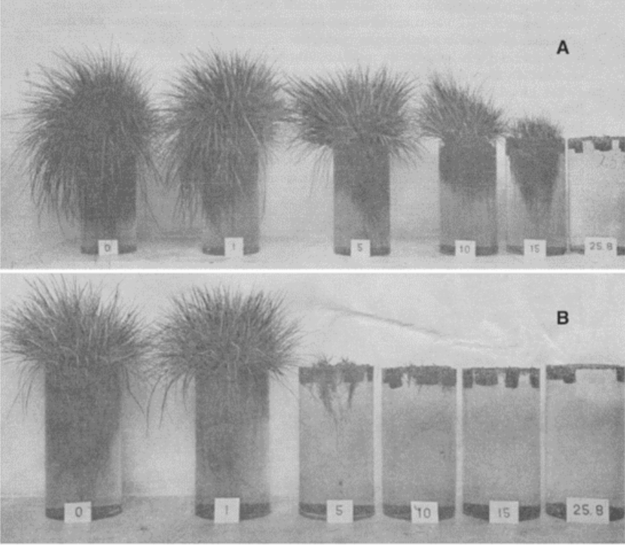Understanding Salt Stress in Plants
Imagine you're a plant, and all you have ever been exposed to is fresh water, but suddenly you are placed in a new environment where the water you're drinking or the soil you are growing in is salty. This change can be quite stressful.
A study by van Zelm et al. (2020) reviewed the current literature and describes just how plants react when exposed to salt. Within just five minutes, plants begin to respond, although these initial reactions are still a bit of a mystery.
With all of these new salt ions in their environment (mainly sodium and chlorine in seawater) the plants experience a few different difficulties. The salt outside of the plant can create an osmotic imbalance where water is pulled out of the plant towards the higher salt concentrations in the soil or water instead of inwards into the plant. This causes effects to the plant similar to drought stress. The plant can also get confused, and bring these salts inside their cells. This may make the plant “forget” to consume other important nutrients (like potassium and nitrogen) or it can lead to a toxic environment inside the plant from high concentrations of the salts.
As the plant continues to experience this salt stress, its growth rate changes. To cope with the salt, plants can start storing special compounds called osmolytes. These help them maintain their cell structure in the saltier environment. But this comes at an energy cost and some of the energy that could have gone into growth now goes into managing this salt stress.
Salts can also harm the plant's ability to photosynthesize, which is how plants make their food. This happens because salt can cause the tiny openings on leaves, called stomata, to close, reducing the plant's access to carbon dioxide.
How Different Plants React to Salt
Different plants have different levels of salt tolerance. Stofberg (2016) conducted an experiment on five Dutch plants that are all found in the same freshwater ecosystems in the Netherlands. When four out of the five species were introduced to low levels of salt, after seven weeks they grew less, had more leaves die and fall off. However, one species was almost unaffected by even the highest salinity levels in the experiment.
Even within the same species, plants can have different reactions to salt. In one experiment, Zijlstra (1946) showed that red fescue plants grown from wild seeds and commercial seeds had very different responses to salinity. In the experiment the wild seeds were able to grow much better in higher concentrations of salt.
So what causes these differences? And how does this help us understand how to grow plants with salty or brackish water at Mediamatic?
From Zijlstra (1946) showing red fescue grown from (A) seeds collected from a tidal flat and (B) commercial seed grown in different concentrations of salt, increasing from 0 to 25.8.
Halophytes: The Salt Champions
While salt can be challenging for many plants, some have evolved to thrive in salty environments. These plants are called halophytes. They have special adaptations that allow them to handle salt better than other plants. For instance, they can adjust to salty conditions more efficiently and have unique ways of managing salt within their cells. Some, like quinoa, or the sea aster even have special cells to store and get rid of excess salt.
Using these plants in the gardens and aquaponics systems at Mediamatic can allow us to use salty canal water for the plants, without making major changes to the systems, or having to work to reduce the salt in these systems.
Salinity and Agriculture
As our world changes, understanding how crops react to salt becomes crucial. In the Netherlands, a study at Salt Farm Texel tested various crops' salt tolerance. Surprisingly, some crops, like certain potatoes and carrots, could handle salt levels that would typically be considered high without any loss in yield.
There's also growing interest in using halophytes in agriculture. These salt-loving plants could be a solution for areas where freshwater is scarce. Some halophytes, like quinoa, are already popular foods. Others might be used to improve soil quality or even protect coastlines.
Conclusion
As saline water becomes more common due to factors like rising sea levels and over-extraction of freshwater, understanding how plants react to and cope with salt becomes vital. While some plants struggle, others, especially halophytes, show incredible resilience. By studying these plants and their adaptations, we can better prepare for a future where freshwater might be in short supply.
Sources
Stofberg, S (2016). De invloed van zout op natuurlijke vegetatie. Watercycle research institute.
van Zelm, E., Zhang, Y., & Testerink, C. (2020). Salt Tolerance Mechanisms of Plants. Annual review of plant biology, 71, 403–433.
Zijlstra, K. (1946). Over de gevoeligheid van enige landbouwgewassen voor zeewater. Versl. Landbouwk. Onderz. 52. 2B .
